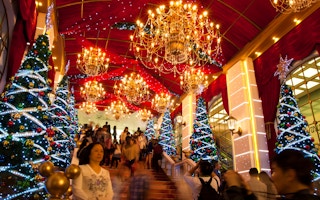December might not be the best time of the year to talk about sustainability. Shopping malls are decorated with sparkling Christmas trees. Office buildings are illuminated with festive lightings. Hotels and restaurants are ready to embrace the party crowds and tourists with tempting feasts. It is a time for celebration and consumption. Yet, as well intended as the season of giving and joy is, there are unintended negative impacts behind the festive scene.
Quick facts behind the festive scene
While the financial cost of the holidays is relatively easier to measure, the environmental costs of festive celebrations have not been much considered. A survey by GreenPower provides a glimpse of the environmental impacts of festive consumption and waste:
- In 2013, a total of 388 tonnes of rubbish were collected from Hong Kong’s 14 Chinese New Year’s Eve markets. From Victoria Park alone, 148 tonnes were collected.
- On Christmas Eve 2007, about 5 tonnes of rubbish were collected from around Tsim Sha Tsui.
- 67 per cent of the respondents said that sea cucumber, fish maws and abalones are consumed in their Chinese New Year Eve’s dinner, some of which are facing extinction due to over-fishing.
- If every person in Hong Kong was to give one thoroughly-wrapped present, 138 tonnes of wrapping paper would be used, requiring 2,400 tress and 240,000 litres of petroleum as raw materials.
- Over 70 million red packets (Hongbao) are wasted in Hong Kong every year – equivalent to felling 3,600 trees every year.
There are things that we can do to make the festive celebration more sustainable, ethical and pleasant for all. In this festive season, here are some ideas of what companies can do to be more responsible and celebrate the festive season in a sustainable style.
Sustainable Christmas dinner
Food lies at the heart of the festive season. Most companies have the tradition of organising team dinners and year-end parties. However, food is usually at the bottom of companies’ sustainable procurement list, if included at all. As indicated in the GreenPower survey results, most of the festive menus include seafood.
A recent South China Morning Post article also revealed the “true price of Hong Kong’s insatiable appetite for seafood”. If you plan to avoid contributing to the extinction of seafood species and have a sustainable Christmas dinner menu, do refer to WWF ’s Seafood Guide, which labels seafood species into “Green - Recommended”, “ Yellow - Think twice” and “Red - Avoid” categories and is easily accessible in a phone app.
If you are still looking at restaurant options for your next team dinner, WWF has also provided a list of restaurants that are already sourcing sustainable seafood and providing an “ocean-friendly” menu in Hong Kong.
Sustainable Christmas trees
Christmas tree is another priority on the festive season purchase list. For shopping malls, hotels and property managers, is there any sustainable Christmas tree option other than buying a new, fancy and expensive, either artificial or real, Christmas tree every year? Admittedly, it takes some innovation and imagination.
As a pioneer initiative of the 2015 holiday season, the Langham hotels around the world took on the challenge of creating “completely sustainable Christmas trees”: nothing could be bought new and no element of the trees could be store-bought.
The employees were asked to look through the waste materials generated from hotels, and use their creativity to design and build sustainable Christmas trees that are made from these materials. For example, one of Langham Hospitality Group’s hotels in Hong Kong, Eaton, used recycled water pipes of different sizes to craft their two-metre tall Christmas tree (as shown in the picture above).
In addition to the sustainability element, employee engagement also plays an important role in Langham’s initiative. As mentioned by Ms. Carmen Ng, the corporate director of sustainability at Langham, “Several hotels took this activity to become their own departmental competition to get all colleagues participating and stimulating their creativity”.
For companies in Hong Kong that are considering providing their employees with an opportunity to design their own sustainable Christmas trees, another option can be partnering with social enterprises and organizations like MakerBay, where upcycle Christmas tree design workshops are offered, which can be a good choice for team building and events like family day.
LED lighting
With festive lighting decorations, the stiff and serious office buildings make people feel warm and cozy during the festive season. It is also an indispensible part of the festive celebration. However, according to a research in the UK, a display of 100 five-watt bulbs switched on for six hours a day over the festive period could consumer 207 kWh, the equivalent of 22.8 days of the average British household’s electricity consumption. One of the easiest ways to lower Christmas electricity bills is by buying energy-saving LED decorative lighting.
“
Some of the best practices mentioned above show that, December can be the best time to talk about sustainability.
Although these LED lighting often costs more than traditional alternatives, it is estimated that they use 90 per cent less electricity than traditional tungsten bulbs and also last much longer. By doing a simple math of how many nights and hours the festive lighting needs to be turned on, a smart CSR manager may immediately want to persuade their companies to switch to LED decorative lighting. Even if it’s too late for this Christmas, it’s still not late to prepare for the next festive season.
Ethical and heartfelt gifts
Instead of giving employees something, companies can donate an item on their behalf and let them know with a card (an electronic one). The “Unwrapped” initiative by Oxfam provides such a channel for companies that are looking for “more than a hamper” for their employees, clients and business partners.
With choices ranging from sponsoring girls to go to schools and providing rural villages with hygiene education, the gift “receiver” may feel the warm glow of having helped someone in need and creating a positive impact in the festive season.
Moreover, the festive season can also be a time for companies to reward the sustainability champions internally, as well as to encourage employees to pursue their own interests in volunteering activities and use their paid volunteer leave during the festive season.
Even when companies are considering “real” gifts, there are also plenty of meaningful ones that could support local communities and disadvantaged groups. For example, The Bank of East Asia (BEA) invited representatives of Heng On Integrated Vocational Rehabilitation Service to its Head Office recently, who brought along their hand-made saori hand-woven items to sell in the staff canteen.
BEA staff members purchased these items as gifts for themselves or their families. The initiative was well received by the employees, while also supporting people with disabilities and handcraftsmanship.
Some of the best practices mentioned above show that, December can be the best time to talk about sustainability – to involve employees in an innovative and meaningful festive celebration, as well as to pass the sustainability message effectively to a larger crowd of customers and different stakeholders.
If you haven’t planned a sustainable festive season this year, it might as well be a good time to set a New Year resolution and make a wish for a more sustainable year ahead.
Bowen Gu is a Project Manager, CSR Asia. This post is reproduced from the CSR Asia blog with permission.











